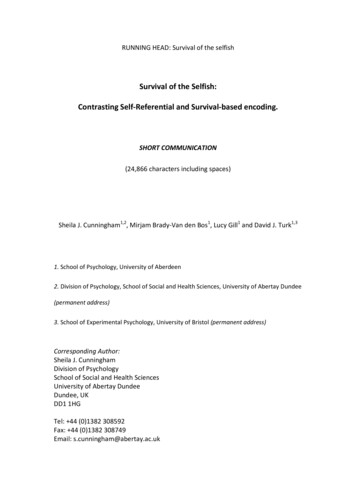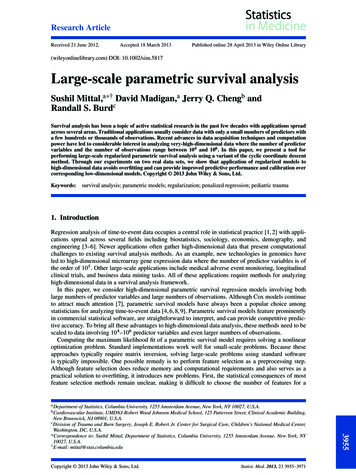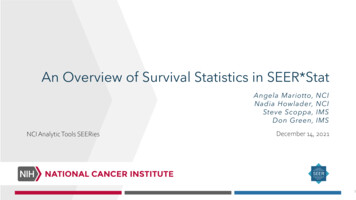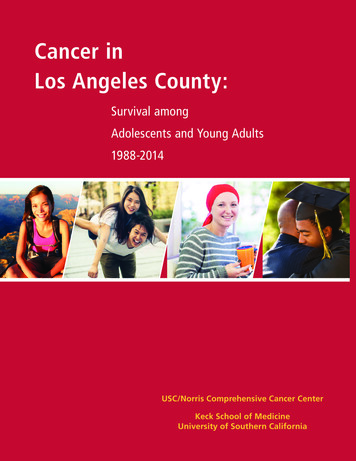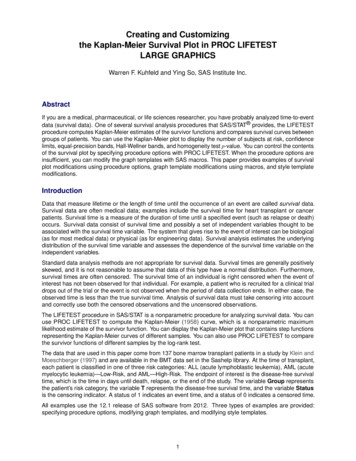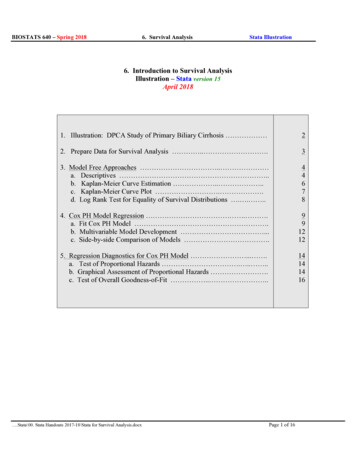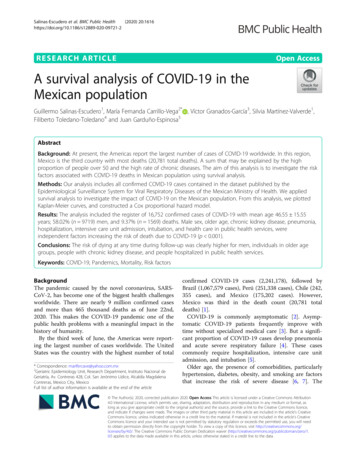
Transcription
Salinas-Escudero et al. BMC Public Health(2020) ESEARCH ARTICLEOpen AccessA survival analysis of COVID-19 in theMexican populationGuillermo Salinas-Escudero1, María Fernanda Carrillo-Vega2* , Víctor Granados-García3, Silvia Martínez-Valverde1,Filiberto Toledano-Toledano4 and Juan Garduño-Espinosa5AbstractBackground: At present, the Americas report the largest number of cases of COVID-19 worldwide. In this region,Mexico is the third country with most deaths (20,781 total deaths). A sum that may be explained by the highproportion of people over 50 and the high rate of chronic diseases. The aim of this analysis is to investigate the riskfactors associated with COVID-19 deaths in Mexican population using survival analysis.Methods: Our analysis includes all confirmed COVID-19 cases contained in the dataset published by theEpidemiological Surveillance System for Viral Respiratory Diseases of the Mexican Ministry of Health. We appliedsurvival analysis to investigate the impact of COVID-19 on the Mexican population. From this analysis, we plottedKaplan-Meier curves, and constructed a Cox proportional hazard model.Results: The analysis included the register of 16,752 confirmed cases of COVID-19 with mean age 46.55 15.55years; 58.02% (n 9719) men, and 9.37% (n 1569) deaths. Male sex, older age, chronic kidney disease, pneumonia,hospitalization, intensive care unit admission, intubation, and health care in public health services, wereindependent factors increasing the risk of death due to COVID-19 (p 0.001).Conclusions: The risk of dying at any time during follow-up was clearly higher for men, individuals in older agegroups, people with chronic kidney disease, and people hospitalized in public health services.Keywords: COVID-19, Pandemics, Mortality, Risk factorsBackgroundThe pandemic caused by the novel coronavirus, SARSCoV-2, has become one of the biggest health challengesworldwide. There are nearly 9 million confirmed casesand more than 465 thousand deaths as of June 22nd,2020. This makes the COVID-19 pandemic one of thepublic health problems with a meaningful impact in thehistory of humanity.By the third week of June, the Americas were reporting the largest number of cases worldwide. The UnitedStates was the country with the highest number of total* Correspondence: marifercave@yahoo.com.mx2Geriatric Epidemiology Unit, Research Department, Instituto Nacional deGeriatría, Av. Contreras 428, Col. San Jerónimo Lídice, Alcaldía MagdalenaContreras, Mexico City, MexicoFull list of author information is available at the end of the articleconfirmed COVID-19 cases (2,241,178), followed byBrazil (1,067,579 cases), Perú (251,338 cases), Chile (242,355 cases), and Mexico (175,202 cases). However,Mexico was third in the death count (20,781 totaldeaths) [1].COVID-19 is commonly asymptomatic [2]. Asymptomatic COVID-19 patients frequently improve withtime without specialized medical care [3]. But a significant proportion of COVID-19 cases develop pneumoniaand acute severe respiratory failure [4]. These casescommonly require hospitalization, intensive care unitadmission, and intubation [5].Older age, the presence of comorbidities, particularlyhypertension, diabetes, obesity, and smoking are factorsthat increase the risk of severe disease [6, 7]. The The Author(s). 2020, corrected publication 2020. Open Access This article is licensed under a Creative Commons Attribution4.0 International License, which permits use, sharing, adaptation, distribution and reproduction in any medium or format, aslong as you give appropriate credit to the original author(s) and the source, provide a link to the Creative Commons licence,and indicate if changes were made. The images or other third party material in this article are included in the article's CreativeCommons licence, unless indicated otherwise in a credit line to the material. If material is not included in the article's CreativeCommons licence and your intended use is not permitted by statutory regulation or exceeds the permitted use, you will needto obtain permission directly from the copyright holder. To view a copy of this licence, visit http://creativecommons.org/licenses/by/4.0/. The Creative Commons Public Domain Dedication waiver ) applies to the data made available in this article, unless otherwise stated in a credit line to the data.
Salinas-Escudero et al. BMC Public Health(2020) 20:1616characteristics of COVID-19 may vary depending on thedemographic and epidemiological profiles of each country. In the specific case of Mexico, 27% of the populationis over 50 years old [8] and there is a high rate of chronicdiseases [9, 10] which may increase the risk of fatalcomplications.Assessing the instantaneous rate of death at any timeduring follow-up for the specific risk factors is crucial todetermine the appropriateness of the mitigation strategies and to set up priorities to control the COVID-19epidemic. This is especially so for countries that are inthe present moment focusing their efforts on fightingthe pandemic; this is the case of Mexico. The presentanalysis aimed to investigate the risk factors associatedwith COVID-19 deaths in the Mexican population usingsurvival analysis.MethodsDesign and settingsThe data released by the Mexican Ministry of Health(Secretaría de Salud, SS) through the EpidemiologicalSurveillance System for Viral Respiratory Diseases onsuspected viral respiratory disease cases were used forthe present analysis [11]. The database included all positive, negative, and suspected cases of COVID-19 registered by 475 Viral Respiratory Disease Monitoring Units(Unidades Monitoras de Enfermedad Respiratoria viral;USMER by its Spanish acronym) and by the medicalunits that attended the cases.The information recorded on every individual includes: sex, age, nationality, place of residence, migratorystatus, chronic diseases, immune-suppression, and otherdiseases reported by the individual, smoking and pregnancy. Data registered on the COVID-19 event includes:type of first contact medical unit (SS or private services),management received (either hospitalization or outpatient), and dates of onset of COVID-19 symptoms, admission to hospitalization, development of pneumonia,admission to intensive care units (ICU), intubation, anddeath. Data on the evolution during the stay in the medical units were not released for public use.All the confirmed cases of COVID-19 registered fromFebruary 21st to April 28th, 2020, were used in thepresent analysis. Eleven records were eliminated as theonset of symptoms and the time of death were registeredwith the same date. The original dataset included sevencases with symptoms starting on February 21st, 7 daysbefore the first case was officially reported. Thus, theseregisters were eliminated from the survival analysis.VariablesThe outcome variable was time to death, constructed asthe time between date of symptoms onset and deathPage 2 of 8(failure) with censoring on April 28th, 2020 for individuals who were alive by the end of the study period.Our analysis considers the following variables: age, sex,comorbidities, pregnancy, immune-suppression, smoking, time elapsed between the onset of symptoms andhospitalization, and death, as well as the time elapsedfrom admission to health care unit to death, development of pneumonia, hospitalization, ICU admissions, intubation, and the type of health service.The survival analysis and the Cox proportional hazardmodel included dichotomic values for sex, morbidity(yes or no for each disease), pneumonia, hospitalization,ICU, and intubation. We grouped health services into 5categories: IMSS, ISSSTE, SS, Other Public Services, andPrivate Services. We grouped age in four tiers: 25 yearsold, 25–49 years old, 50–74 years old, and 75 years old.Statistical analysisThis paper describes continuous variables using meansand standard deviations ( SD), and categorical variablesexpressed as number and percentage (%). The mortalityrate per 1000 person-years was calculated for the generalsample and both sexes. Histograms were graphed to assess the symmetry in the dispersion of the values to select the best test to use. In addition, the bias-kurtosisand Shapiro-Wilk tests were used to evaluate the normality of the covariates and select the statistical tests.Since no variable had a normal distribution, comparisons between individuals who died versus those whosurvived, were made through the Mann-Whitney test forcounting variables, and x2 for categorical variables.The Kaplan-Meier method was used to plot survivalcurves. These graphs served to test the proportional hazard assumption. We fitted a Cox’s Proportional HazardsModel including the covariables of interest using a stepforward process, i.e. from a null model, all the covariateswith p 0.05. were included in the model. The data wasanalyzed with the statistical package software Stata version 14.0 (StataCorp, College Station, Texas, USA).ResultsThis analysis includes 16,752 registers of confirmedcases of COVID-19. The mean age of the individualswas 46.55 15.55 years, 58.02% (n 9719) were men,and 9.37% (n 1569) died. The general mortality ratewas 4.94 (95% CI 4.70–5.19) per 1000 person-year, formen 5.82 (95% CI 5.48–6.18) per 1000 person-year, andfor women 3.74 (95% CI 3.43–4.08) per 1000 personyear (Table 1).When comparing individuals who died versus thosewho survived, the deceased were older (59.42 14.29)and mostly men (67.94%), (p 0.001). The prevalence ofCKD in people who died (6.86%) was larger in comparison to those who did not die (p 0.001). In individuals
Salinas-Escudero et al. BMC Public Health(2020) 20:1616Page 3 of 8Table 1 General characteristics by outcomeAge, yearsSex (men)Totaln 16,752Deadn 1569Aliven 15,183p-value46.55 15.5559.42 14.2945.22 15.06 0.001 a9719 (58.02)1066 (67.94)8653 (56.99) 0.001 bcMortality rate (95% CI)4.94 (4.70–5.19)cMen (95% CI)5.82 (5.48–6.18)Women (95% CI)c3.74 (3.43–4.08)ComorbiditiesDiabetes3064 (18.44)266 (17.12)2798 (18.58)0.158 bCOPD421 (2.53)44 (2.83)377 (2.5)0.435 bAsthma585 (3.52)51 (3,.28)534 (3.55)0.588 bHypertension3640 (21.91)353 (22.72)3287 (21.82)0.418 bCardiovascular disease473 (2.85)43 (2.77)430 (2.86)0.878 bObesity3463 (20.83)340 (21.86)3123 (20.73)0.293 bCKD388 (2.34)107 (6.86)281 (1.87) 0.001 bNumber of comorbidities0.72 0.940.77 0.950.71 0.940.029 aNo comorbidities9173 (54.76)417 (26.58)8756 (57.67) 0.001 bPregnancy99 (0.59)5 (0.32)95 (0.62)0.138 bImmune-suppression314 (1.89)25 (1.61)289 (1.92)0.391 bSmoking1496 (9)150 (9.62)1346 (8.94)0.368 bOnset of symptoms-admission (days)4.27 3.434.29 3.494.26 3.420.730 aOnset of admission-dead (days)5.86 5.125.86 5.12–Onset of symptoms-dead (days)10.15 5.7510.15 5.75–Pneumonia4942 (29.5)1182 (75.33)3760 (24.76) 0.001 bHospitalized6581 (39.28)1416 (90.25)5165 (34.02) 0.001 bICU720 (4.3)292 (18.61)428 (2.82) 0.001 bIntubated709 (4.23)376 (23.96)333 (2.19) 0.001 bIMSS services6262 (37.57)667 (42.65)5595 (37.04) 0.001 bISSSTE services905 (5.43)124 (7.93)781 (5.17) 0.001 bSS services7896 (47.37)655 (41.88)7241 (47.94) 0.001 bOther public services684 (4.1)87 (5.56)597 (3.95)0.002 bPrivate services922 (5.53)31 (1.98)891 (5.9) 0.001 baMann-Whitney testχ testMortality rate per 1000 person-yearCOPD Chronic Obstructive Pulmonary Disease, CKD Chronic Kidney Disease, ICU Intensive Care Unit, IMSS Mexican Institute of Social Services, ISSSTE Institute ofSocial Security and Services for State Workers, SS Mexican Ministry of Healthb 2cwho survived, the proportion without comorbidities washigher (p 0.001). The period from the onset of symptoms to admission in hospitalization was similar betweenboth groups (4.27 3.43, p 0.7302). The period fromthe onset of symptoms to death, and the period from admission to death were 10.15 5.75 and 5.86 5.12 days,respectively. Among the people who died 75.33% (n 1182) developed pneumonia, 90.25% (1416) was hospitalized, 18.61% (n 292) was admitted to the ICU, and23.96% (n 376) needed intubation. These proportionswere higher in comparison to individuals who did notdie (p 0.001). In the group of those who died, 42.65%received health care from IMSS, while in the survivinggroup, 47.94% received health care from SS services(Table 1).The survival analysis comprises a total of 16,734 registers, 1558 of whom died. Our analysis observed a cumulated total risk time of 315,773 days. The Kaplan-Meiersurvival plots for the prognostic factors that resulted statistically significant are presented in Fig. 1. As can be inferred from the plot, risk is directly proportional to agegroup. The proportional hazards assumption is satisfied
Salinas-Escudero et al. BMC Public Health(2020) 20:1616Fig. 1 Kaplan-Meier survival plots for different prognostic factorsPage 4 of 8
Salinas-Escudero et al. BMC Public Health(2020) 20:1616Page 5 of 8since survival risk curves do not cross during the analyzed period. Individuals who developed pneumonia,those with a previous diagnosis of CKD, and those whowere admitted to hospitalization, have approximately30% lower probability of survival after 20 days ofhospitalization than individuals who did not presentthese characteristics. People who were admitted to ICU,have about 40% less probability of survival after 20 daysof hospitalization than individuals who did not enter thisunit. Finally, individuals who needed intubation have justabout 50% probability of survival after 20 days ofhospitalization compared to individuals who were notintubated.The Kaplan-Meier plots demonstrated that the risk ofmortality was different between sexes. Thus, KaplanMeier curves were plotted for men and women (Supplementary material 1 and 2), and multivariable Cox proportional hazards regression models were run for eachsex. The hazard ratios for both sexes can be seen inTable 2. For women, the multivariable model containingthe significant covariates was statistically significant(x2 22.22, df 10, p 0.01). At any time during followup, age increases the risk of dying, and that risk was significantly high in older women, who had 4.41 times therisk of dying compared with the youngest age group.Women with CKD were 1.90 times likely to die compared with women without this disease. Twice as manywomen who developed pneumonia had died comparedto women who did not develop this complication. Atany time during the follow-up, women admitted tohospitalization were 6.57 times as likely to die comparedwith those who were not admitted to a hospital. Womenwho needed intubation were 2.83 times as likely to diecompared with those who did not require intubation.Women receiving health care from IMSS services had4.34 times the risk of dying compared to women who received health care in private facilities.The multivariable Cox proportional hazards regressionmodel for men was statistically significant (χ2 31.83, df 12, p 0.001) and is presented in Table 2. The risk of dyingwas notably higher for men over 75 years old. They had15.46 times the risk of dying compared with the youngestage group. Men with CKD were 1.79 times more likely todie compared with men without this disease. Pneumoniaand intubation multiplied by 2.05 and 3.12 respectively therisk of dying for men. Men admitted to hospitalization andICU were 5.42 and 1.39 times as likely to die, respectively,compared with those who did not enter these units. At anytime during follow-up, men who needed intubation were3.12 times as likely to die compared with those who did notrequire intubation. Men who received health care fromIMSS had 6.35 times the risk of dying compared to thosewho received health care in private facilities.DiscussionThe results of our analysis, with the Kaplan-Meier survivalmethod and multivariable Cox proportional hazards regression model, demonstrated that men had a higher riskof dying due to COVID-19. In both sexes, older age, CKD,development of pneumonia, hospitalization, intubation,and health care in public health services are independentrisk factors increasing the risk of death due to COVID-19.ICU admission was a significant risk factor only in men.Table 2 Hazard ratio for the fatal outcome in women and menWomenHazard RatioMenp-value95% CI for the Hazard RatioHazard Ratiop-value95% CI for theHazard Ratio4.850.0071.55Age a25–49 y15.1350–74 y2.37p 0.0011.882.998.71p 0.0012.7927.1375 y4.41p 0.0013.325.8715.46p 0.0014.9148.70Chronic kidney disease1.90p 0.0011.362.661.79p 0.0011.402.30Pneumonia2.09p 0.0011.632.672.05p 0.0011.742.42Intubation2.83p 0.0012.203.631.390.0011.151.69Hospitalization6.57p 0.0014.699.223.12p 0.0012.573.795.42p 0.0014.256.914.34p 0.0012.288.26Health Services (Private, reference)IMSS ServicesISSSTE Services3.120.0011.576.186.35p 0.0014.069.92SS Services3.22p 0.0011.706.082.85p 0.0011.754.64Other Public services2.760.0061.355.653.52p 0.0012.275.47Women reference group 49 years, Men reference group 24 yearsIMSS Mexican Institute of Social Services, ISSSTE Institute of Social Security and Services for State Workers, SS Mexican Ministry of Healtha
Salinas-Escudero et al. BMC Public Health(2020) 20:1616The systematic review and meta-analysis from Galbadage et al. [12] showed that men are more likely to diefrom COVID-19 than women. Although a clear explanation of this association has not been established yet, ithas been suggested that some biological and immunological pathways can play an essential role in the differential behavior of COVID-19 [13]. Some sociobehavioral and cultural aspects can also explain themore unfavorable scenario for men [14, 15]. It has beenreported that being over 50 years old increases the riskof fatal complications for this disease [16, 17]. Both sexand old age play an essential role in the risk of the Mexican population. It is especially striking that men in theoldest age group have about 16 times the risk of dyingfrom COVID-19.ICU admission and intubation are indicators of highlevel severity of the disease, both represent an increasedrisk of death [18]. In our analysis, intubation representsa notable risk factor since it more than doubles the riskof death in both men and women.The mean time from the onset symptoms to death(Table 1) was different from that reported in other studies suggesting that death occurs between 14 and 21 daysafter the onset of symptoms [19]. We found that thetime between the onset of symptoms until seeking carewas similar between people who died and those whosurvived (p 0.7302). It can be hypothesized that peoplewith a high risk of severe COVID-19, e.g. with comorbidities, arrived in a critical state to the health services.A high proportion (58%) of people who survivedCOVID-19 had no comorbidities. The high prevalence ofchronic diseases, in both individuals who died and thosewho did not, reflects the epidemiological context ofMexico [9, 10] but also the impact of chronic disease inthe COVID-19 presentation and severity. These data allows us to hypothesize that chronic diseases may not onlyincrease the risk of complicated disease but also the riskof acquiring the novel coronavirus. A possible explanationis that chronic inflammation, adverse effects on immunomodulation, and metabolic stress that characterize systemic diseases, decrease the ability to react againstexternal agents; in this case, SARS-CoV-2 [20–22].In our analysis, CKD a common comorbidity of diabetes [23] and hypertension [24], increased almost twotimes the risk of death in comparison to people withoutthis disease. Cheng et al. [25] reported that 13.1% of thepeople admitted to hospitalization in China had kidneyfailure. This prevalence is significantly larger than the2.34% we found in the Mexican population diagnosedwith COVID-19. Besides, in the Chinese study, the mortality rate due to CKD (33%) was more extensive than inour population. While in China, kidney disease was diagnosed at the hospital admission by laboratory tests, inMexico, the diagnosis was registered on a self-reportedPage 6 of 8basis. Thus, the prevalence and mortality due to thiscause may be underestimated in Mexico. The KaplanMeier curves in the Chinese study also show that individuals with kidney disease had a significantly higher riskof in-hospital death. A similar pattern can be observedin the present study. It has been suggested that SARSCoV-2 may bind to renal epithelial cells, injure thesecells, and subsequently disrupt the whole body fluid,acid-base, and electrolyte homeostasis, thus increasingthe failure in those with preexisting CKD therefore accelerating their deaths [26, 27].A relevant finding of our analysis is that the crude lethality rate of 9.4% is above the 5.3% initially reported inHubei, China [28], and 6.05% in the United States. However, it is below the 11.76% for Spain, 13.98% for Italy,14.37% for the United Kingdom and 19.35% for France[29]. Such discrepancies can be explained by the way theCOVID-19 cases are confirmed and deaths registered. Inmost countries, only in-hospital deaths are recorded,and in countries like Mexico, in the absence of symptoms, tests are not used in large quantities [30].Finally, according to our results, different health service providers may have an essential role in lethality.Public providers reported a larger risk of death in comparison with private ones. IMSS presents the highest riskof death (hazard ratio 4.34 in women and 6.35 in men),followed by SS services (hazard ratio 3.22 and 3.52 inwomen and men, respectively). It is especially importantto note that SS and IMSS are the institutions that havereceived the most cases of COVID-19 in this epidemic,both of uninsured and insured population, hence, havinga high probability of over saturation.The analysis of these results must consider some limitations. First, the dataset does not include clinical variables related to the evolution of the COVID-19, whichcould have been useful in adjusting the model. Second,since the COVID-19 pandemic is ongoing, not all outcomes of the pandemic have been observed. Finally, Thedatabase contains information on all deaths that wereconfirmed as positive cases of COVID-19. Nevertheless,there is a high percentage of deaths classified as atypicalpneumonia which were not confirmed as cases ofCOVID-19. Those cases may lead to underestimate thecase fatality rate for this disease.Nonetheless, the present paper contributes to understand the dynamics of the pandemic in Mexico. We highlight risk factors for death that have been little studied,especially the presence of CKD and data about the healthsystem that reflects the social inequality in Mexico.ConclusionsThis analysis adds to previous evidence [31] on thehigher risk of death for men and older people, both inMexico and elsewhere. Further research is necessary to
Salinas-Escudero et al. BMC Public Health(2020) 20:1616understand the origin of this differential risk. One of thespecific goals of the basic and clinical research should beto identify differences in response to vaccination to ensure the efficacy of the novel vaccines.We consider that other risk factors will become relevant over time, so epidemiological research will continueto be paramount.Given the persistence of SARS-Cov-2, it is vital tofocus mitigation campaigns on the population at higherrisk of fatal outcomes. We also need stronger publichealth campaigns aimed at reducing the prevalence ofobesity, diabetes, hypertension, and their comorbidities.These conditions may increase the susceptibility of theMexican population to COVID-19 and cause a rapidprogression to severe states of the disease and death.Supplementary informationThe online version contains supplementary material available at nal file 1: Fig. S1. Kaplan-Meier survival plots for different prognostic factors for women. The figure displays the Kaplan-Meier survivalplots according to (A) age, (B) neumonia, (C) CKD, (D) Hospitalized, (E)Health Services, (F) Intubated and (G) Intensive Care Unit. Fig. S2.Kaplan-Meier survival plots for different prognostic factors for men. Thefigure displays the Kaplan-Meier survival plots according to (A) age, (B)neumonia, (C) CKD, (D) Hospitalized, (E) Health Services, (F) Intubated and(G) Intensive Care Unit.AbbreviationsCKD: Chronic kidney disease; COPD: Chronic obstructive pulmonary disease;COVID-19: Coronavirus disease 2019; ICU: Intensive care units; IMSS: MexicanInstitute of Social Security; ISSSTE: Institute of Social Security and Services ofthe State Workers; SARS-CoV-2: Severe acute respiratory syndromecoronavirus 2; SS: Mexican Ministry of Health; USMER: Viral RespiratoryDisease Monitoring UnitsAcknowledgmentsNot applicable.Authors’ contributionsAll authors gave final approval of the version to be published and agreed to beaccountable for all aspects of the work in ensuring that questions related to theaccuracy or integrity of any part of the work were appropriately investigatedand resolved. GSE: Conceptualization, Methodology, Data curation, Formalanalysis, Supervision of the paper writing. MFCV: Conceptualization,Methodology, Writing-Original draft, and final manuscript. VGG: Supervision ofthe paper writing, Writing - Review & Editing. SMV: Writing - Review & Editing.FTT: Writing - Review & Editing. JGE: Writing - Review & Editing.FundingNo funding was received.Availability of data and materialsThe dataset analyzed during the current study is available in the MexicanMinistry of Health repository, 152127Ethics approval and consent to participateThe use of this public dataset did not need ethical approval.Consent for publicationNot applicable.Page 7 of 8Competing interestsThe authors declare no competing interests.Author details1Center for Economic and Social Studies in Health, Hospital Infantil deMéxico Federico Gómez, Mexico City, Mexico. 2Geriatric Epidemiology Unit,Research Department, Instituto Nacional de Geriatría, Av. Contreras 428, Col.San Jerónimo Lídice, Alcaldía Magdalena Contreras, Mexico City, Mexico.3Epidemiological and Health Services Research Unit Aging Area, CentroMédico Nacional, Siglo XXI, Mexico City, Mexico. 4Research Unit inEvidence-Based Medicine, Hospital Infantil de México Federico Gómez,Mexico City, Mexico. 5Research Department, Hospital Infantil de MéxicoFederico Gómez, Mexico City, Mexico.Received: 22 June 2020 Accepted: 16 October 2020References1. Situation report - 154. Coronavirus disease 2019 (COVID-19) [Internet]. 2020.[cited 15th July 2020]. Available from: df?sfvrsn d0249d8d 2.2. Lin C, Y. D, B. X, Z. S, X. L, Z. C. Asymptomatic novel coronavirus pneumoniapatient outside Wuhan: the value of CT images in the course of the disease.Clin Imaging. 2020;22(63):7–9.3. Ma Y, Xu Q-N, Wang F-L, Ma X-M, Wang X-Y, Zhang X-G, et al.Characteristics of asymptomatic patients with SARS-CoV-2 infection in Jinan.China Microbes Infect. 2020;22(4–5):212–7.4. Wu Z, McGoogan JM. Characteristics of and important lessons from thecoronavirus disease 2019 (COVID-19) outbreak in China: summary of areport of 72 314 cases from the Chinese Center for Disease Control andPrevention. JAMA. 2020;323(13):1239–42.5. Lai C-C, Shih T-P, Ko W-C, Tang H-J, Hsuehe P-R. Severe acute respiratorysyndrome coronavirus 2 (SARS-CoV-2) and coronavirus disease-2019 (COVID19): the epidemic and the challenges. Int J Antimicrob Agents. 2020.6. Zheng Z, Peng F, Xu B, Zhao J, Liu H, Peng J, et al. Risk factors of critical &mortal COVID-19 cases: a systematic literature review and meta-analysis. JInfect Dev Ctries. 2020;81(2):e16–25.7. Chen L, Zhang B. MN. T, Yang K, Zou Y, Zhanga S. clinical course of severeand critically ill patients with coronavirus disease 2019 (COVID-19): acomparative study. J Inf Secur. 2020;81(2):e82–e4.8. Proyecciones de la población de México y de las Entidades Federativas,2016–2050 [Internet]. 2020. [cited 16th april 2020]. Available from: http://www.conapo.gob.mx.9. Top 10 causes of death in 2017. Mexico. [Internet]. 2017 [cited 12thSeptember 2020]. Available from: http://www.healthdata.org/mexico.10. Global Burden of Disease. México. [Internet]. 2017 [cited 21st Septembrer2020]. Available from: https://vizhub.healthdata.org/gbd-compare/.11. Bases de datos COVID-19 [Internet]. 2020. [cited 14th april 2020]. Availablefrom: -152127.12. Galbadage T, Peterson BM, Awada J, Buck AS, Ramirez DA, Wilson J, et al.Systematic Review and Meta-Analysis of Sex-Specific COVID-19 ClinicalOutcomes. Front Med (Lausanne). 2020;7:348.13. Salvati L, Biagioni B, Vivarelli E, Parronchi P. A gendered magnifying glass onCOVID-19. Clin Mol Allergy. 2020;4(18):14.14. Lodi E, Scavone A, Reggianini L, Modena MG. COVID-19: a gendereddisease? Possible interpretations and knowledge limitations. G Ital Cardiol(Rome). 2020;21(8):570–4.15. Maleki Dana P, Sadoughi F, Hallajzadeh J, Asemi Z, Mansournia MA, YousefiB, et al. An insight into the sex differences in COVID-19 patients: what arethe possible causes? Prehosp Disaster Med. 2020;35(4):438–41.16. Li K, Wu J, Wu F, Guo D, Chen L, Fang Z, et al. The clinical and chest CTfeatures associated with severe and critical COVID-19 pneumonia. InvestigRadiol. 2020;55(6):327–31.17. Wei C, Liu Y, Liu Y, Zhang K, Su D, Zhong M, et al. Clinical characteristicsand manifestations in older patients with COVID-19. BMC Geriatr. 2020;20(1):395.18. Zareifopoulos N, Lagadinou M, Karela A, Platanaki C, Karantzogiannis G,Velissaris D. Management of COVID-19: The Risks Associated With TreatmentAre Clear, but the Benefits Remain Uncertain. Monaldi Arch Chest Dis. 2020;90(2).
Salinas-Escudero et al. BMC Public Health(2020) 20:161619. Linton NM, Kobayashi T, Yang Y, Hayashi K, Akhmetzhanov AR, Jung S-M,et
The survival analysis comprises a total of 16,734 regis-ters, 1558 of whom died. Our analysis observed a cumu-lated total risk time of 315,773days. The Kaplan-Meier survival plots for the prognostic factors that resulted sta-tistically significant are presented in Fig. 1. As can be in-ferred from the plot, risk is directly proportional to age .
![[ST] Survival Analysis - Stata](/img/33/st.jpg)
